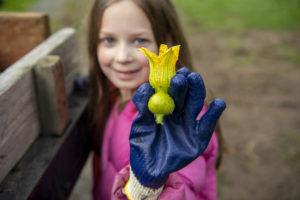
Plenty of schools go on pumpkin patch field trips. Some get to visit grizzly bears at Northwest Trek.
But there’s only one school where you get to grow pumpkins, then hide them for grizzly cubs to find – and that’s Weyerhaeuser Elementary, whose second- and third-graders came to Northwest Trek early this October (and last year too) to do exactly that.
It’s all part of the school’s focus on outdoor STEM education, helped along by volunteer expertise from Trek horticulturalist Jake Pool.
“Look, this one’s enormous!” cried one boy, stepping between vines to a giant Cinderella pumpkin.
“And this one’s tiny!” cried his friend with glee, holding up a pint-sized gourd.
“Oh look, I found a frog,” said a girl in a pink jacket, carefully setting the little green creature out of harm’s way.
Growing pumpkins for animals
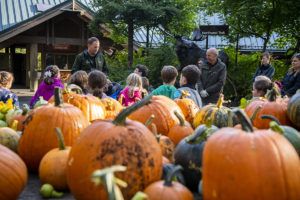
The 15 Weyerhaeuser students were behind the scenes at Northwest Trek where, last spring, second-graders had planted pumpkin starts they’d grown from seed as school. With its focus on hands-on outdoor science, the Eatonville District elementary school has its own greenhouse and weekly gardening lessons from Pool and his wife Kristin, plus other parent volunteers. Other classes include animal and plant biology in the school’s forest, Wildcat Woods.
Over summer, the pumpkin patch grew and grew in the organic compost. And now it was harvest time – with a difference. Each of these pumpkins had been chosen for its nutrition and tastiness for animals, and the students were going to deliver some personally.
First came otters.
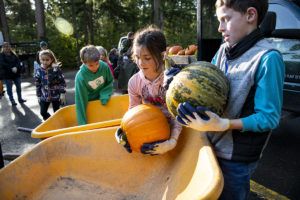
After loading up a truck full of pumpkins from deep orange to stripy green and pale white, the students drove around to the front of the park to fill their orders from keepers. (The rest would be given to animals at the public Pumpkin Chomp ‘n’ Stomp event Oct. 26-27.)
Big, medium, little
“Right: We need two small pumpkins for river otters, two medium pumpkins for gray wolves, and two big ones for grizzlies,” read Pool from his list, sounding a little like a Goldilocks story. “Plus some pumpkin flowers and corn.”
The fairytale vibe continued as the kids excitedly pushed the wheelbarrows into the forested core of the wildlife park. At the Wetlands habitat they met keeper Miranda Mauck, who climbed into the river otter space to position the smallest pumpkins on two logs that jutted over the water.
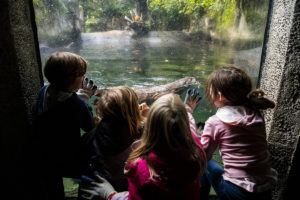
When otters Blakeley and Oakley rushed in, they didn’t pay much attention at first to the pumpkins. Then one scampered up the log and nudged the lower pumpkin, which fell into the pool with a splash.
“Ooooh!!!” cried all 15 kids as one.
Thistle the porcupine got a tiny ear of corn, turning his back on the crowd as he nibbled, with kids asking questions about quills.
“The kids love coming here,” said parent volunteer Amy Krawczyk. “It teaches them responsibility, and what food we can grow. And it makes learning fun.”
Wolves and Bears
Then it was wolf time. Half the class carefully followed keeper Haley Withers into the gray wolf habitat (with wolves securely in their dens) to pick the ideal hiding spot for the two medium pumpkins.
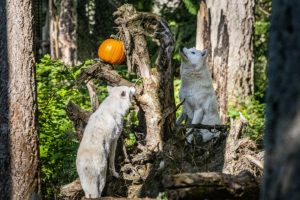
“But you know what will really be cool for these wolves?” asked Pool. “Our scent. They’ve never ever smelled you before, so make sure and run your hands all over the logs and trees. Then they’ll come in and play detective.”
Sure enough, when all the class was safely at the viewing deck, that’s exactly what happened – until one wolf discovered a pumpkin high on a stump, knocked it down and carried it off expertly in massive jaws.
“That’s exactly like they’d carry prey out in the wild,” explained Withers.
“Wow,” chorused the admiring audience.
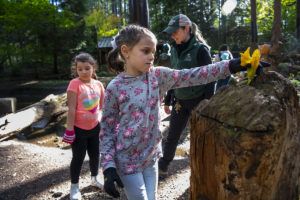
Finally, it was bear time. The other half of the class made their way carefully past the bear dens and into the grizzly cub habitat – not your usual third-grade field trip. One pumpkin went on a stump, another on a log over the pool, with flowers tucked into crevices.
The kids exited, then out came Huckleberry and Hawthorne to general delight, making their way straight to the vegetables and chomping, stomping, swimming and munching with single-minded fervor.
At the viewing decks, kids peppered Withers with questions from wild bear diet to tree-climbing ability.
Learning Science Outside
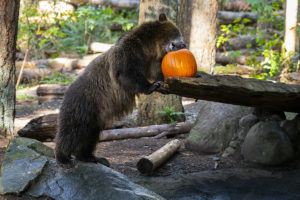
“Outdoor science is so important,” said school principal Linn Ames, as the group watched Withers throw their corn cobs to Benton the black bear.
“It shows these students how we can all work together (for wildlife), and how everything is connected. And it sparks their curiosity to get hands-on with science – not just hearing and reading it, but actually doing it.”
“It’s pretty cool to grow food for animals,” said MacKenzie, in a pink jacket. “Everyone’s got to eat – you can’t live without food.”
“Outdoor education is fun,” added Oliver.
But as the class made their way out, Kai summed it up completely.
“This is the best recess ever!” he cried.
WATCH: See animals get pumpkin treats and enrichments at Pumpkin Chomp ‘n’ Stomp, 9:30am-3pm Oct. 26-27. Free with admission.